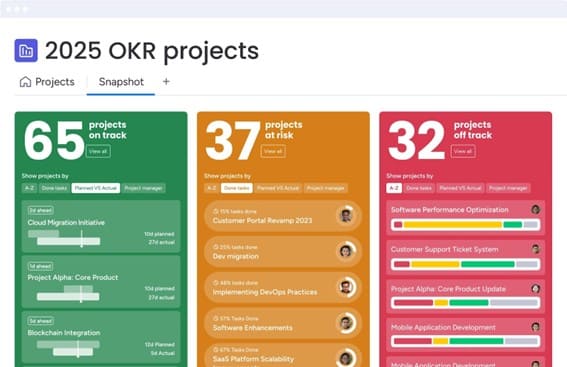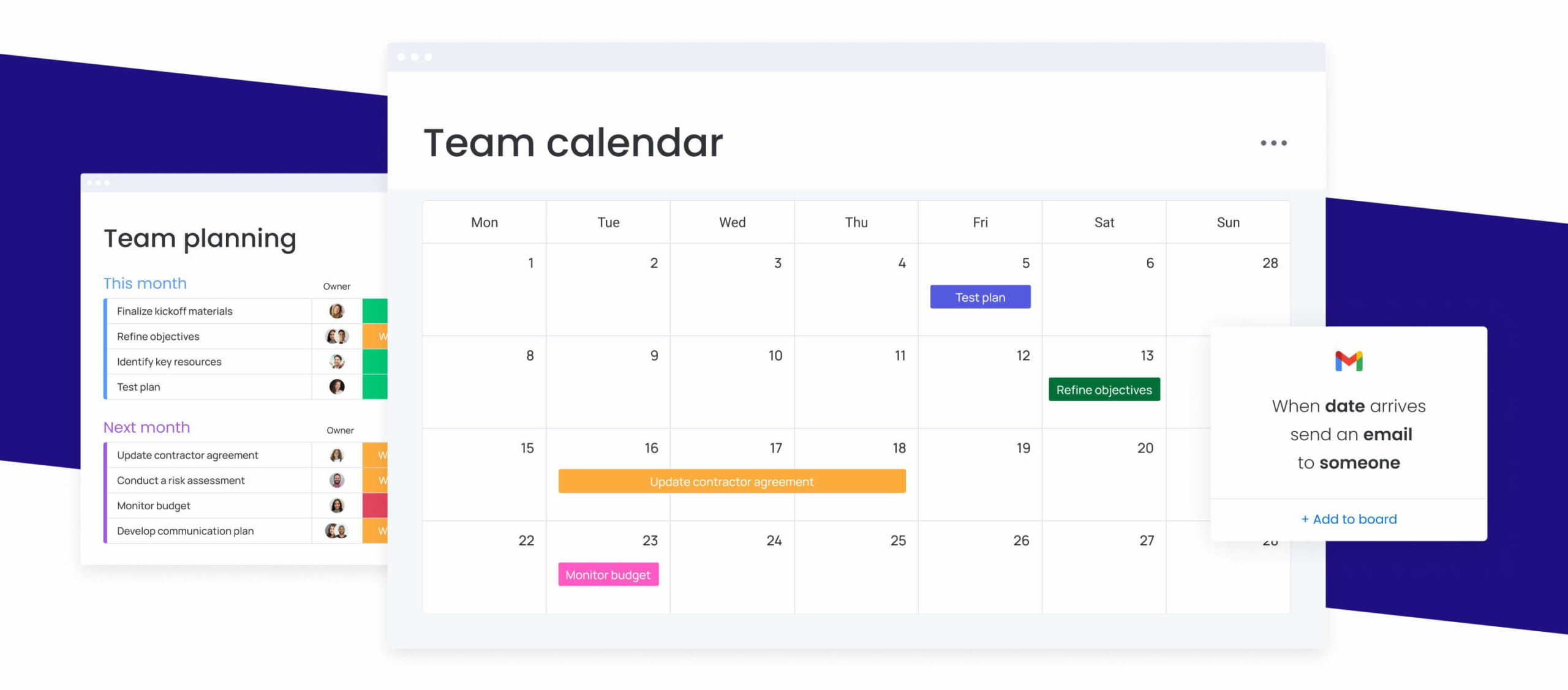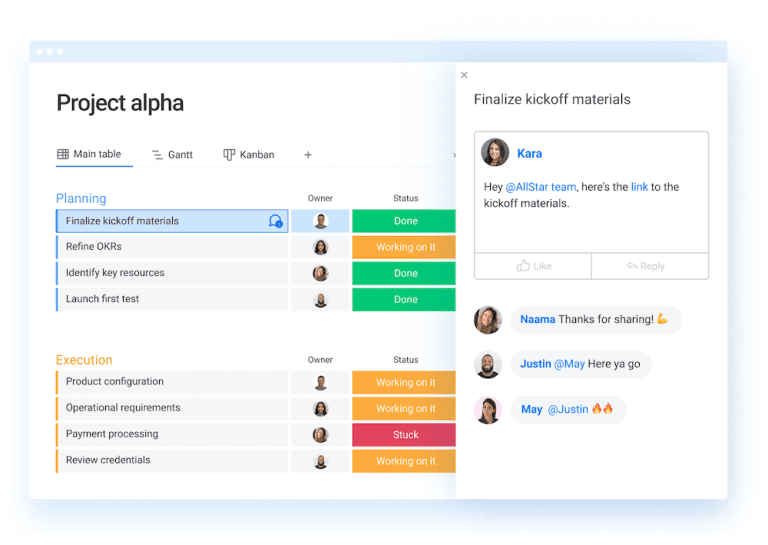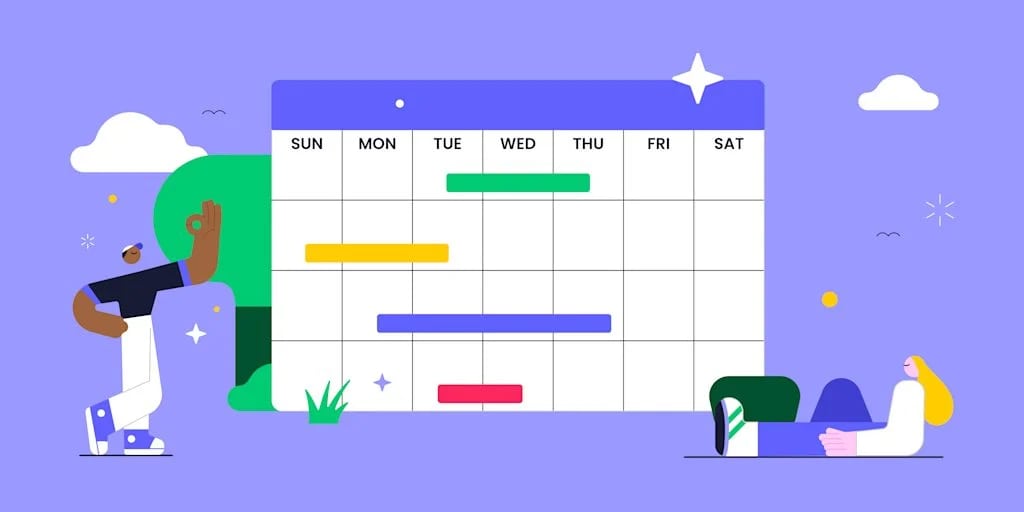Behind every successful project is a well-managed budget. When spending is scattered across spreadsheets or tracked manually, even strong teams can lose sight of their financial limits. The result is often missed deadlines, surprise overages, and a scramble to justify costs after the fact.
A project budget template brings structure and visibility to that process. It helps teams outline expected expenses, monitor spending in real time, and make quick adjustments when priorities shift. With a clear framework in place, you can balance resources, protect profit margins, and maintain trust with stakeholders throughout the project lifecycle.
Whether your team is managing a marketing campaign, software rollout, or construction project, the templates listed in this post give you the foundation to plan with precision and track with confidence. By pairing a solid budgeting framework with a connected platform, you can transform budgeting from a reactive task into a proactive advantage that keeps every project on time and on target.
Key takeaways
- Match your template to the project: marketing teams need ROI tracking, while construction projects require contingency planning for material cost changes.
- Track planned vs. actual spending: review budgets weekly to catch variances early and prevent small issues from turning into major overruns.
- Automate for visibility: monday work management turns static templates into dynamic dashboards with real-time collaboration, automated alerts, and approval workflows.
- Cover every cost category: include labor, materials, overhead, and contingency to maintain complete financial visibility and avoid budget surprises.
- Scale as complexity grows: use simple templates for smaller projects, then upgrade to advanced solutions when manual tracking becomes time-consuming or error-prone.
What is a project budget template?
A project budget template is a pre-formatted document that helps you plan, track, and control project expenses from start to finish. By following this template you have a ready-made structure for organizing costs, monitoring spending, and keeping your project budget financially on track.
In simple terms, this is your financial roadmap: templates outline expected costs and help you allocate resources where they’re needed most. You can monitor spending patterns, spot cost variance (when actual costs differ from planned costs), and organize expenses into categories like labor, materials, and overhead.
Templates also save you from building budgets from scratch every time. They provide consistency across projects, reduce errors, and help you make smarter financial decisions — a critical advantage when research shows only 36% of organizations are likely to deliver projects within budget.

9 essential project budget templates for teams
Different projects need different budget approaches. Choosing the right template ensures you capture all costs and avoid financial surprises.
Here are nine great templates designed for specific team needs and project types:
Marketing campaign budget template
Marketing budgets focus on campaign performance and proving return on investment. You’ll track spending across channels, measure results, and adjust quickly based on what’s working.
For example, a marketing campaign budget needs to prove its value. A strong template provides the structure to track every dollar, from ad spend to content creation, and connect it directly to performance metrics.
- Digital advertising costs: track spending on social media, search ads, and display campaigns.
- Content creation expenses: monitor costs for copywriting, design, and video production.
- Influencer partnerships: manage fees, deliverables, and performance metrics.
- ROI measurement tools: connect spending to revenue and conversion metrics
Modern work management platforms like monday work management can simplify campaign tracking by combining expense data with performance dashboards. This level of visibility allows teams to shift resources toward high-performing channels in real time and stay confident that every dollar supports measurable results.
Construction project budget template
Construction projects operate in unpredictable environments where costs can change quickly. Material price fluctuations, weather delays, and unexpected site conditions all demand a flexible budgeting approach that still maintains strong cost control.
An effective construction budget template should include:
- Material price tracking: monitor vendor quotes, compare suppliers, and flag rising costs early.
- Change order management: document scope changes and approvals to keep financial records accurate.
- Permit and inspection tracking: record fees and compliance expenses to prevent project delays.
Every construction budget should also include project contingency planning to account for unplanned events such as weather disruptions or supply chain issues. Building this buffer into your budget helps protect overall profitability when conditions shift unexpectedly.
IT project budget template
IT budgets balance one-time implementation costs with ongoing operational expenses. Your template needs to handle both initial setup and long-term maintenance planning.
Essential components cover software licensing with renewal tracking, hardware procurement and depreciation, development hours by sprint or phase, and cost tracking for ongoing operational expenses. IT teams also need version control for budget updates as technical requirements evolve.
Event planning budget template
Event budgets juggle multiple vendors and last-minute changes, requiring templates that track deposits, manage vendor relationships, and accommodate sudden adjustments.
- Vendor payment scheduling: track deposits, instalments, and final payments.
- Contingency planning: build buffers for weather, attendance changes, or vendor issues.
- Real-time expense tracking: monitor spending as the event approaches.
- Post-event reconciliation: compare actual costs to estimates for future planning.
Event planners also benefit from event budget templates that connect vendor contracts to payment schedules (this prevents missed deposits and helps maintain vendor relationships across multiple events).
Product development budget template
Product budgets follow development stages from concept to launch. Your template should release funds based on milestones while maintaining flexibility for iteration.
These templates track research and discovery costs, design and prototyping expenses, testing and validation budgets, and launch preparation spending. Product teams need visibility into how much each development phase costs to make informed decisions about feature priorities.
Consulting services budget template
Consulting projects require careful balance between billable hours, client expectations, and overall profitability. A well-structured budget template helps track time, manage expenses, and ensure projects stay financially healthy across multiple engagements.
Include these key elements in your consulting budget:
- Hourly rate structures: outline billing rates by consultant level to standardize pricing and track revenue accurately.
- Expense reimbursement tracking: record travel, lodging, and client-related costs for timely reimbursement and transparency.
- Project profitability analysis: compare billable hours against costs to evaluate margins and identify areas for improvement.
- Client billing integration: connect budgets with invoicing systems to simplify billing and ensure consistency across projects.
Non-profit program budget template
Non-profit budgets navigate complex funding restrictions and donor requirements. Your template must track restricted and unrestricted funds while demonstrating program impact.
These templates manage:
- Grant compliance tracking: monitor spending against funder requirements.
- Donor reporting automation: generate reports showing fund usage and impact.
- Volunteer cost calculations: quantify in-kind contributions for grant applications.
- Program outcome measurement: connect spending to mission impact.
Non-profits also need templates that satisfy both financial accountability and mission reporting. Platforms like monday work management can really help here by automating donor reports and tracking restricted funds across multiple programs.
Start-up budget template
Start-up budgets typically plan for uncertainty and rapid change, requiring templates with scenario planning, runway calculations, and investor reporting capabilities.
Essential features include burn rate monitoring, cash runway projections, scenario modelling for different growth rates, and investor-ready financial reports.
Many teams further rely on a startup budget template that adapts quickly as business models evolve and funding rounds close.
Multi-project portfolio budget template
Portfolio budgets provide oversight across multiple initiatives and need consolidated views that show both detailed project cost tracking as well as high-level organizational spending.
These templates excel at resource allocation across projects, risk assessment at portfolio level, consolidated reporting for executives, and inter-project dependency tracking. Organizations managing complex portfolios use these templates to balance resources and identify opportunities for cost savings across projects.
Key components every project budget template must include
Every effective budget template needs core components that ensure comprehensive planning and accurate tracking. These elements work together to give you complete financial visibility throughout your project.
Budget categories and cost breakdowns
Categories organize your expenses into logical groups for easier tracking and analysis. This cost breakdown structure often includes labor costs, materials and supplies, overhead expenses, and vendor payments.
Precise categorization helps you:
- Spot spending patterns: see where money goes and identify savings opportunities.
- Improve future estimates: use category data to plan upcoming projects.
- Simplify reporting: generate reports that stakeholders understand instantly.
When categories stay consistent across projects, it becomes easier to compare performance, forecast costs, and refine accuracy over time. Platforms like monday work management make this even simpler by allowing teams to customize categories that align with their accounting processes and automatically update as projects progress.
Planned vs actual expense tracking
Budget variance illustrates the gap between what you planned to spend and what you actually spent. This comparison reveals whether your project stays on track financially.
Tracking variance helps you catch overspending early and make adjustments. For example, you might reallocate funds from underspent areas or request additional budget before problems escalate. Regular variance analysis transforms budget management from reactive to proactive.
Resource allocation and capacity planning
Your budget must reflect real team capacity and resource availability. Resource utilization measures how effectively you use available time and materials throughout the project.
This alignment prevents overcommitment and burnout. When budgets match actual capacity, teams deliver sustainably without sacrificing quality or morale.
Project timeline and milestone integration
Budget phases should sync with project milestones for smooth cash flow management. This alignment ensures funds arrive when you need them and supports staged approval processes.
Milestone-based budgeting gives you:
- Tighter financial control: release funds based on completed work.
- Improved stakeholder confidence: show progress through achieved milestones.
- Reduced financial risk: avoid committing all funds upfront.
Risk and contingency planning
Every project faces unexpected costs. Contingency funds and risk buffers prepare you for surprises without derailing the entire budget.
Smart contingency planning considers project complexity, historical performance, vendor reliability, and market conditions, and using a cost benefit analysis template can help further evaluate unexpected expenses.
Keep in mind that higher-risk projects may need larger buffers, often ranging from 5 to 15% of the total project cost, to maintain financial stability when challenges arise.

How to select the perfect budget template for your team
The right budget template shapes how effectively your team plans, tracks, and manages costs. It should match your project’s complexity, fit your workflow, and align with any industry or compliance needs.
Before choosing, think about what matters most to your team — from project size and reporting frequency to collaboration and integration requirements. The sections below outline how to assess each factor so you can select a template that keeps budgets accurate, transparent, and easy to manage.
Evaluate your project scope and complexity
How complex is your project financially? Simple projects might need basic expense tracking, while complex initiatives require detailed cost management across multiple categories and phases.
Consider these factors:
- Number of cost categories: more categories need more sophisticated templates.
- Stakeholder involvement: multiple approvers require clear workflows.
- Regulatory requirements: compliance needs drive template complexity.
- Reporting frequency: regular reports need automated data collection.
Consider your team structure and workflow
Your template should support how your team actually works. Distributed teams need cloud-based collaboration, while co-located teams might prefer simpler shared documents.
Think about decision-making processes, approval workflows, update frequency, and collaboration needs: the right template enhances your existing workflow rather than forcing new processes.
Assess integration and collaboration needs
Modern projects span multiple systems. Your budget template should connect with project management platforms, accounting software, and reporting dashboards to eliminate duplicate data entry.
Integration reduces errors and saves time. When budget data flows automatically between systems, teams spend less time on manual updates and more time on strategic decisions.
Match templates to industry requirements
Every industry manages budgets differently, with unique cost structures, regulations, and reporting expectations. Choosing a template designed for your field helps ensure financial accuracy and compliance from the start.
Consider what your template should include:
- Industry-specific cost categories: for example, healthcare tracks regulatory and training expenses, while manufacturing monitors supply chain and equipment costs.
- Compliance tracking: built-in fields for certifications, audits, or safety requirements.
- Standardized reporting formats: align with industry reporting standards or client expectations.
- Approval workflows: ensure the right stakeholders review budgets before spending begins.
Simple budget templates vs advanced budgeting solutions
Budgeting needs evolve as projects and teams grow. A template that works perfectly for a small, straightforward project may fall short once multiple departments, approvals, or reporting layers come into play. The key is finding the right level of structure for your organization’s current stage while leaving room to scale.
The following sections outline when simple templates are most effective and when advanced budgeting solutions make more sense for managing complex, fast-moving projects.
When basic templates work best
Simple spreadsheet templates excel for small teams and straightforward projects, help you to start immediately without training or setup costs.
Basic templates work when:
- Projects are self-contained: limited dependencies and stakeholders.
- Budgets are stable: few changes after initial planning.
- Teams are small: minimal collaboration requirements.
Reporting is simple: basic charts meet stakeholder needs.
Advanced features for complex projects
As projects scale, budgets become harder to manage with static spreadsheets alone. Advanced budgeting solutions bring automation, collaboration, and visibility together, helping teams stay proactive instead of reactive.
Key features include:
- Automated variance alerts: get notified instantly when spending deviates from plan.
- Predictive analytics: forecast future costs and resource needs based on real-time data.
- Multi-project views: monitor portfolio-wide financial health at a glance.
- Audit trails: track every budget change for compliance and accountability.
Work management platforms such as monday work management make these capabilities accessible without overwhelming teams. You can start with simple templates and gradually layer in automation, integrations, and reporting tools as projects grow in scale and complexity.
How to make the transition to sophisticated budgeting
Knowing when to move beyond basic templates is key to keeping budgets accurate and scalable. Signs you are ready for an upgrade include hours lost to manual updates, recurring reporting errors, and growing demands for deeper financial insights. These challenges are often compounded by the fact that 57% of employees report an increase in the number of software tools they use compared to the previous year.
Begin your shift gradually with pilot projects. Test advanced features or explore budget planning software to manage forecasting and complex cost structures. Starting with one team or department helps refine the process, build confidence, and ensure a smooth transition before rolling out organization-wide.
Implement your project budget template in 5 easy steps
Successful budget implementation follows a clear process. These five easy-to-follow steps establish strong financial controls while keeping your team focused on project delivery.
Step 1: define budget categories and parameters
A strong budget starts with well-defined categories that reflect how your organization spends and approves funds. Setting clear boundaries ensures consistency and helps every team member understand where costs belong.
Common categories include:
- Direct labor: wages, contractor payments, and related benefits.
- Materials and supplies: equipment, raw materials, and consumables.
- Vendor services: outsourced work such as design, marketing, or consulting.
- Overhead allocation: utilities, rent, and administrative expenses.
- Contingency reserves: funds set aside for unexpected costs or scope changes.
Documenting these categories — along with approval thresholds and spending limits — creates the foundation for accurate, transparent budget tracking across projects.
Step 2: set baseline costs and estimates
Build realistic baselines using multiple estimation techniques, as cost estimation in project management helps maintain budget accuracy. Historical data provides starting points, while expert judgment validates assumptions.
Document your estimation methods for future reference. Include assumptions about resource availability, market conditions, and project scope. Realistic baselines set appropriate expectations from the start.
Step 3: track and record actual expenses
Create a rhythm for expense tracking that matches your project pace. Fast-moving projects need daily updates, while longer initiatives might update weekly.
Assign clear responsibility for data entry and validation. Use automated data capture where possible to reduce manual work and improve accuracy. Regular tracking keeps budgets current and useful for decision-making.
Step 4: monitor budget variance in real time
Tracking planned versus actual spending keeps projects financially on course. Establish clear thresholds for action — for example, a 5% variance might prompt a team review, while a 10% variance requires stakeholder attention.
Work management platforms such as monday work management make this process effortless by visualizing variances through automated alerts and live dashboards. Teams can spot trends early, investigate causes, and make quick adjustments before issues escalate..
Step 5: create reports and share insights
Finally, be sure to transform budget data into actionable insights for different audiences. Executives need high-level summaries, while project teams require detailed breakdowns.
Effective reports highlight:
- Key metrics: budget health, variance trends, and risk areas.
- Recommended actions: specific steps to address issues.
- Future projections: expected spending based on current patterns.

Customize budget templates for your industry needs
Generic templates miss industry-specific requirements that can make or break your budget accuracy. Customization ensures you capture all relevant costs while meeting compliance needs.
Different industries face unique financial challenges. Healthcare manages regulatory compliance costs. Manufacturing tracks complex supply chains. Technology handles rapid change and iteration.
Industry customizations typically address:
- Specialized cost categories: industry-specific expense types.
- Compliance requirements: regulatory reporting needs.
- Approval workflows: industry-standard review processes.
- Risk factors: common industry-specific budget risks.
Teams using monday work management can build industry-specific templates once and share them across projects. This standardization improves accuracy while reducing setup time for new initiatives.
Transform your project budgeting with monday work management
Modern project budgeting requires more than spreadsheets: you must have integrated systems that connect financial planning with project execution, resource management, cost management, and stakeholder communication.
monday work management transforms budget templates into living financial dashboards. Real-time expense tracking shows exactly where you stand. Automated calculations eliminate manual errors. Further, visual dashboards make budget health instantly clear to all stakeholders.
The platform also handily connects budgets with project timelines, resource allocation, and team workloads. When project scope changes, budget impacts become immediately visible. When resources shift, cost implications update automatically.
Advanced automations for budget control
Eliminate manual budget monitoring with powerful automations that keep your project finances on track. Set up custom triggers that alert the right people at exactly the right moment.
- Create budget threshold notifications when spending reaches 75% of allocation.
- Automatically flag expense items that exceed estimated costs by more than 10%.
- Schedule weekly budget summary reports delivered to stakeholders’ inboxes.
- Trigger approval workflows when new expenses are added to high-risk categories.
200+ integrations for seamless financial workflows
Connect your budget templates directly to the tools your finance team already uses. Eliminate double-entry and ensure your project budget always reflects the latest financial data.
- Sync expense data from accounting platforms like QuickBooks and Xero.
- Import timesheet information from payroll systems for accurate labor costing.
- Connect with procurement tools to track purchase orders against budget lines.
- Integrate with ERP systems for enterprise-wide financial visibility.
Powerful AI features for budget optimization
Leverage AI to move from reactive budget management to proactive financial planning. Let monday AI analyze spending patterns and recommend optimizations.
- Generate budget forecasts based on historical project performance.
- Receive AI-powered suggestions for reallocating underutilized funds.
- Identify potential cost overruns before they impact project delivery.
- Create natural language budget reports with a single prompt.
Real-time budget visualization for stakeholder confidence
Transform complex financial data into intuitive visuals that build trust and facilitate faster decisions. Keep everyone aligned on budget priorities without spreadsheet fatigue.
- Color-coded budget health indicators show status at a glance.
- Interactive charts reveal spending trends across project phases.
- Customizable dashboards for different stakeholder information needs.
- Side-by-side planned vs. actual visualizations highlight variances instantly.
Key features that enhance budget management include customizable budget columns, automated variance alerts, integrated approval workflows, and real-time dashboard reporting. Teams can build exactly the budget tracking they need without complex setup or coding.
Whether you’re managing a single project or an entire portfolio, monday work management scales with your needs. Start with simple templates and add sophistication as your projects grow.
Frequently asked questions
How often should I update my project budget template during an active project?
Update your project budget template weekly for active projects to maintain accuracy and enable timely decisions. High-velocity projects or those with frequent changes may need daily updates, while stable, long-term projects might work with bi-weekly reviews.
Can project budget templates handle international projects with multiple currencies?
Yes, many project budget templates support multi-currency tracking with built-in conversion features for international projects. Advanced platforms like monday work management offer real-time exchange rate updates and consolidated reporting across all currencies in your portfolio.
Which file format should I choose for my project budget template?
Excel and budget template Google Sheets solutions work well for simple projects due to their flexibility and universal compatibility. For complex projects requiring collaboration and integration, specialized platforms like monday work management offer enhanced features while maintaining easy data import/export capabilities.
How do project budget templates handle scope changes during execution?
Project budget templates handle scope changes through change order tracking and budget revision workflows that maintain financial control. Effective templates include version control, approval processes, and variance analysis to show the financial impact of scope adjustments clearly.
Should my project budget template include indirect costs like overhead?
Yes, include indirect costs such as overhead and administrative expenses in your project budget template for complete financial visibility. This comprehensive approach ensures accurate project profitability analysis and supports better pricing decisions for future projects.
What approval workflows integrate best with project budget templates?
The most effective budget approval workflows include clear threshold definitions, designated approvers by spending level, and automated notifications for pending approvals. Modern platforms like monday work management embed these workflows directly into templates, ensuring consistent approval processes across all projects.
 Get started
Get started 

